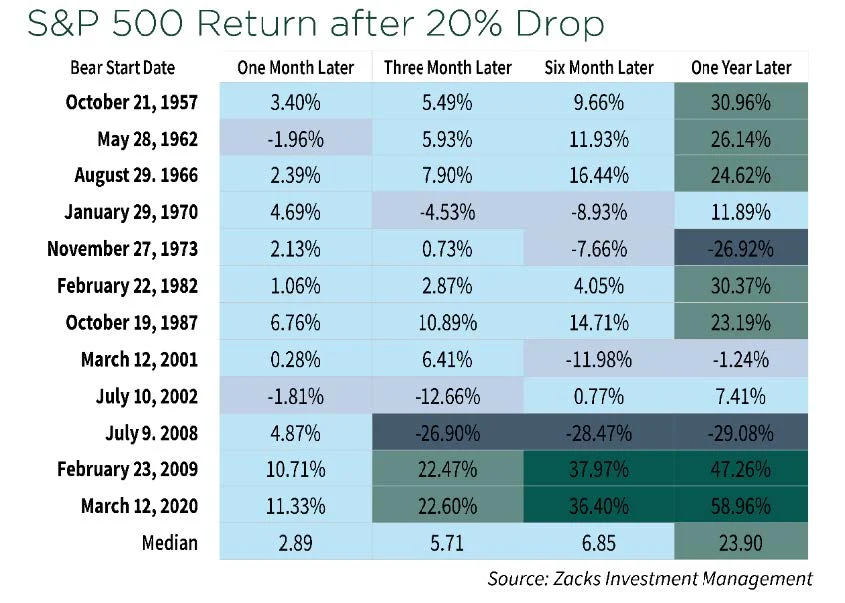Stocks Enter a Bear Market – Here’s What Investors Should Do Next
U.S. stocks entered a technical bear market three weeks ago, with the S&P 500 index declining more than -20% from its January peak. The downdraft has been led by technology shares, which disproportionately impact the broad index’s returns since technology is the largest sector by market capitalization. As of this writing, tech shares are down over -30% from their peak.1
It’s also true, however, that technology shares remain over +20% higher than they were pre-pandemic, which signals the market is simply repricing some of the exorbitant gains posted in the second half of 2020 and throughout 2021. Remember, too, that U.S. stocks soared more than +100% from the Covid-19 bear market lows, which means this current retracement of – 20%—while unpleasant and unwelcomed—does not make equity investors any worse off than they were two years ago. In fact, U.S. household net worth is still hovering around all-time highs, thanks in large part to +20% gains in home equity over the past year.2
Our advice to investors now is not to get drawn into the fear narratives that always accompany sharp stock market declines. In our four-plus decade career, every bear market we’ve seen has been accompanied by a sense of dread that the U.S. economy now faces an existential problem that will persist for many years. This time around the problem is inflation, which many believe can only get worse. There is also a seemingly widely-held belief that the U.S. economy is already in freefall, which has driven pessimism to extremes.
Case in point: last week’s University of Michigan Consumer Sentiment Survey found that Americans are more dissatisfied with the economy today than they were in the depths of the 2008 Global Financial Crisis. The unemployment rate climbed to 10% during that time and almost 10 million Americans lost their homes. Today, there are more available jobs than there are unemployed people, and discretionary spending remains relatively strong. Spending on everything from airline tickets, to hotel stays, to restaurants has been going up, which is the type of activity you’d expect to see in good times – not dreadful ones.
We’re seeing this same disconnect in the small business space, a key engine of growth for the U.S. economy. Normally, small business sentiment about the economy is tightly correlated with hiring plans – optimistic small business owners make plans to hire more workers, and vice versa. But today the opposite is true. Small businesses are reporting low levels of optimism about the economy, but at the same time, they’re trying to bring on more workers.
This leads us to believe we are experiencing a sentiment-driven bear market that is not likely to resemble the big, fundamentally-driven bear markets of 2000 and 2008. We’ve seen this outcome many times throughout history. There have been 26 bear markets since 1929, but only 15 of them were tied to a recession. We are still estimating over 2% GDP growth for the U.S. this year.
As we have written many times before, we are not proclaiming the U.S. economy to be in perfect shape with all concerns and fears being unwarranted. We are simply highlighting that current sentiment reflects an economy that is mired in recession, when in fact jobs are plentiful, profit margins are high, and fundamental indicators like services PMI and consumer spending are signaling growth. The wider the gap between how investors and consumers feel relative to how the economy is performing, the closer we think we get to see a market low.
The table below shows how the S&P 500 has historically responded in the months and years after closing in a bear market. While we cannot know whether or for how long the bear market will continue, we do know that periods of weak returns have almost always been followed by periods of strong returns.

Bottom Line for Investors
As for what investors should do now, our answer is not to panic and to stick to your plan. Trying to time the bottom of a bear market is hazardous and ripe for making a serious misstep, so we strongly caution against attempting to do so. About a third of the stock market’s best days have happened within the first two months of a bull market, which we will only be able to confirm with the benefit of hindsight. The biggest risk now, in our view, is being on the sidelines when that happens.
- Wall Street Journal. June 14, 2022. https://advisor.zacksim.com/e/376582/t-11655184522-mod-hp-lead-pos7/4m4hcr/492147790?h=FEDjr1VlvbbLPnK0WB5r0dp2ZmOrkHXabRPw-3QqXFQ
- Hartford Funds. 2022. https://advisor.zacksim.com/e/376582/ets-html-text-Watch20for202025/4m4hcv/492147790?h=FEDjr1VlvbbLPnK0WB5r0dp2ZmOrkHXabRPw-3QqXFQ%3A%20Market,of%2010%25%2D19.9%25
DISCLOSURE: Past performance is no guarantee of future results. Inherent in any investment is the potential for loss.
Zacks Investment Management, Inc. is a wholly-owned subsidiary of Zacks Investment Research. Zacks Investment Management is an independent Registered Investment Advisory firm and acts as an investment manager for individuals and institutions. Zacks Investment Research is a provider of earnings data and other financial data to institutions and to individuals.
This material is being provided for informational purposes only and nothing herein constitutes investment, legal, accounting or tax advice, or a recommendation to buy, sell or hold a security. Do not act or rely upon the information and advice given in this publication without seeking the services of competent and professional legal, tax, or accounting counsel. Publication and distribution of this article is not intended to create, and the information contained herein does not constitute, an attorney-client relationship. No recommendation or advice is being given as to whether any investment or strategy is suitable for a particular investor. It should not be assumed that any investments in securities, companies, sectors or markets identified and described were or will be profitable. All information is current as of the date of herein and is subject to change without notice. Any views or opinions expressed may not reflect those of the firm as a whole.

